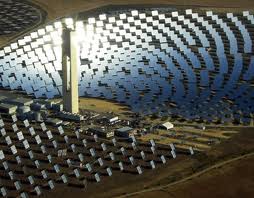The concentrated solar power (CSP) sector is expected to finally spring to life – and begin its long-awaited journey down the cost curve – as the oil and gas-rich Gulf nations deploy their massive sovereign wealth in solar technologies.
At the climate change talks in Doha, both Saudi Arabia and the host country Qatar reinforced their intentions to invest tens of billions of dollars into large-scale CSP – which includes solar thermal and concentrated solar PV technologies. The biggest oil and gas exporters in the world want to become, well, the Saudi Arabia and Qatar of the solar industry too.
Saudi Arabia intends to spend $110 billion on installing more than 41GW of solar over the coming two decades, including 25GW of CSP – aware that replacing its oil-based power plants will free up more crude to be exported into the international market. Qatar intends to build 1.8GW of large-scale solar by 2020 and has a 30 per cent renewables target by 2030. Much of this will come from CSP – and the first pilot plants featuring parabolic trough technologies were opened last week to coincide with Doha.
They are not alone in the Gulf region. Abu Dhabi was the first mover in this space, taking $15 billion out of its sovereign fund to invest in solar. It recently opened its 100MW Shams 1 CSP plant, has built the futuristic Masdar clean energy city, and is the home of the International Renewable Energy Agency. Dubai is building a 1GW solar park, and Kuwait, which already has a 50MW CSP facility, is aiming for 15 per cent renewables (almost all CSP) by 2030.
“The Gulf has oil and gas, and it has the sun,” one UAE official told me this week in the Gulf pavilion at Doha. “And oil and gas are finite.”
Indeed, in the final days of the conference, Qatar, Saudi Arabia, UAE and Bahrain, said they had pledged to reduce their carbon emissions, as part of a plan to diversify their economies away from fossil fuels.
The strategy is significant because the sheer weight of investment and deployment will almost certainly spark the slump down the cost curve which did not occur after the initial deployment of CSP petered out in Spain, and failed to eventuate in the US as proposed projects were substituted by cheaper flat panel PV technologies. Australia has proved unable to construct the right incentives – or political will – to construct CSP plants, and most other developments are occurring in China, South Africa and India.
CSP is considered critical if any of the 100 per cent renewable energy scenarios are to be implemented, because it has the ability to add storage and provide “dispatchable” energy – allowing it to smooth over and fill in the gaps between intermittent sources such as wind and solar.
It is considered by some to be expensive, but last week IRENA released an assessment that suggested CSP costs per could be around $140-$180 a megawatt-hour in areas of the best solar resources – such as the Gulf states and Australia, and technologies such as solar towers have the greatest potential for further cost reductions. (That is around half the recent cost assessment of Australia’s Bureau of Resource and Energy Economics).
Further deployment will push the technology further down the cost curve, just as Germany’s incentive caused PV costs to fall dramatically, and Gulf money could provide that incentive. Many developers see their ultimate cost of energy below $100/MWh, as we have reported here and here.
The Gulf states are interested in solar because it will allow them to export more oil and gas to the more lucrative international markets, rather than consuming them at heavily subsidies levels in their domestic market. But their energy needs are growing so quickly that they risk becoming energy importers as well. The UAE already imports gas from Qatar.
And as Hussam Khonkar, from the King Abudulaziz City for Science and Technology in Saudi Arabia told a forum on renewables in Gulf countries during the Doha conference, CSP could also address issues around desalination, which accounts for a growing part of the kingdom’s energy requirements.
He said the KACST is looking at combining solar thermal technologies with nano-membrane technology, and to replace regular fossil-fuel based desalination plants with ultra-high concentrator PV. The Saudis also told the Financial Times last week that they were also looking at exporting solar power to Europe, possibly through a vehicle such as the Desertec initiative, which proposes to build HVDC transmission lines from the solar-rich Middle East and north Africa to help Europe meet its long-term renewables goals.
The auction for the first 200MW of Qatar’s solar program is expected to be held within the next three months. Saudi Arabia is still to unveil details of how it will roll out its plan, although it has signalled that it will auction the first 2GW of solar capacity in the next year – replicating the sort of auction process that has proved successful in South Africa and India. It has already commissioned a series of demonstration projects, including a 1MW plant to be constructed next year by Australia’s Solar Systems, which is developing a dish-based concentrated solar PV (CPV) technology.
Another intriguing alternative for the Saudis is simply to deploy their riches and go out and buy the technologies themselves. As one advisor noted, there is no shortage of distressed solar companies. From the Saudis’ point of view, the timing could not be better.







